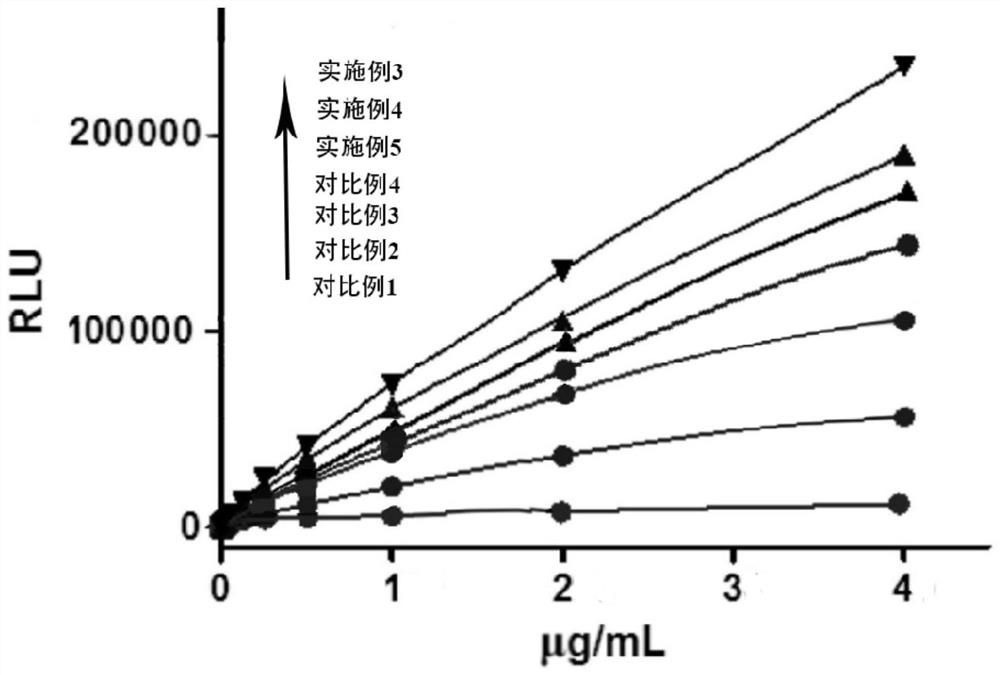An organic-inorganic hybrid material for single-molecule detection and its preparation method
A single-molecule detection and hybrid material technology, applied in the field of nanomaterials, can solve the problems of weak fluorescence intensity and limitation of gold nanoclusters, and achieve the effect of fast detection speed and high sensitivity
- Summary
- Abstract
- Description
- Claims
- Application Information
AI Technical Summary
Problems solved by technology
Method used
Image
Examples
Embodiment 1
[0031] Example 1: Preparation of modified polyphenylene sulfide.
[0032] Take a piece of dried polyphenylene sulfide with a number-average molecular weight of 20,000 g / mol, weigh 1 g, and add it to a 50-mL branch-mouthed flask. 3 The oleum was mixed well, heated in a water bath at 100 °C for 1 h, the crude product was ultrafiltered with collodion, ethanol and ether were added, and after standing for half an hour, centrifuged, the supernatant was removed, ethanol and ether were added, and the centrifugation was repeated. 3 times, and after vacuum drying, water-soluble sulfonated polyphenylene sulfide is obtained.
[0033] Weigh 30ml of concentrated nitric acid into 70ml of deionized water to form a concentrated nitric acid solution with a volume fraction of 30%, then add 0.5g of the water-soluble sulfonated polyphenylene sulfide prepared above, and treat in a water bath at 80°C for 2 hours. The modified polyphenylene sulfide product was washed with deionized water and ethanol...
Embodiment 2
[0034] Example 2: Preparation of modified polyphenylene sulfide-modified gold nanoparticles.
[0035]The toluene solution of cetyltrimethylammonium bromide (6mL, 44.4mM), the aqueous solution of chloroauric acid (20mL, 0.6mol / L) and the cosurfactant n-butanol (0.5mL) were added to 50mL of In the conical flask, after all the chloroauric acid was transferred to the organic layer, add modified polyphenylene sulfide (500mg, 7mM); after the modified polyphenylene sulfide was dissolved, slowly add the newly prepared sodium citrate solution ( 2mL, 0.05mol / L), stirred at room temperature for 6h, stopped stirring after the reaction, poured the upper layer solution into a single-necked flask for rotary evaporation, concentrated the toluene solvent to 2mL, added 400mL of anhydrous ethanol, stored at -4°C for 8h and centrifuged , separate the ethanol solution, repeat the centrifugation twice, put the obtained modified polyphenylene sulfide-modified gold nanoparticles in a vacuum drying ov...
Embodiment 3
[0036] Example 3: Preparation of organic-inorganic hybrid materials for single molecule detection.
[0037] Under a constant temperature water bath of 40°C, 220 mL of absolute ethanol, 5 mL of deionized water, and 14 mL of ammonia water were added to a 500 mL one-neck flask; under constant stirring, 11.2 mL of tetraethyl orthosilicate was added, and after the reaction for 12 h, the reaction solution was centrifuged and anhydrous Ethanol washing, deionized water dispersion, freeze-drying to obtain nano-silica.
[0038] Weigh 3.5 g of the above-obtained nano-silicon dioxide into a 250-mL two-necked flask, add 175 mL of anhydrous ethanol, and uniformly disperse by ultrasonic to obtain a nano-silica suspension. Add 157mL of absolute ethanol and 17mL of deionized water to another 250mL two-necked flask, add 105μL of glacial acetic acid to adjust the pH to 5, add 7g of γ-aminopropyltrimethoxysilane dropwise, stir to dissolve it, and dissolve the nano-dioxide. The silicon suspension...
PUM
| Property | Measurement | Unit |
|---|---|---|
| size | aaaaa | aaaaa |
Abstract
Description
Claims
Application Information
 Login to View More
Login to View More - R&D
- Intellectual Property
- Life Sciences
- Materials
- Tech Scout
- Unparalleled Data Quality
- Higher Quality Content
- 60% Fewer Hallucinations
Browse by: Latest US Patents, China's latest patents, Technical Efficacy Thesaurus, Application Domain, Technology Topic, Popular Technical Reports.
© 2025 PatSnap. All rights reserved.Legal|Privacy policy|Modern Slavery Act Transparency Statement|Sitemap|About US| Contact US: help@patsnap.com

